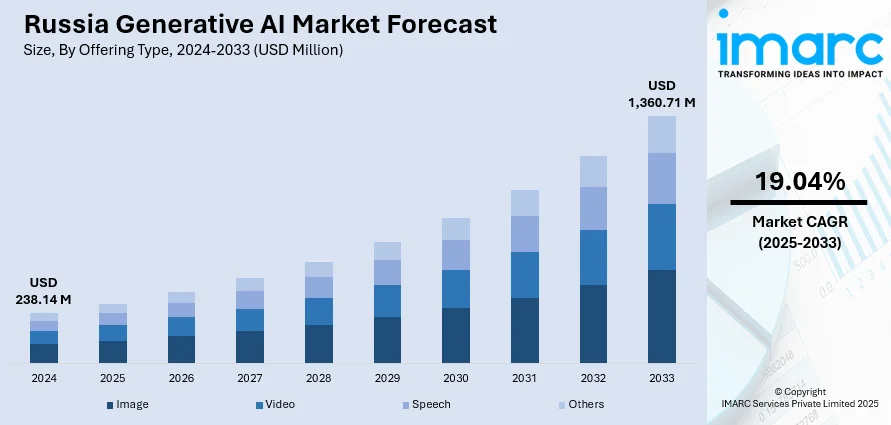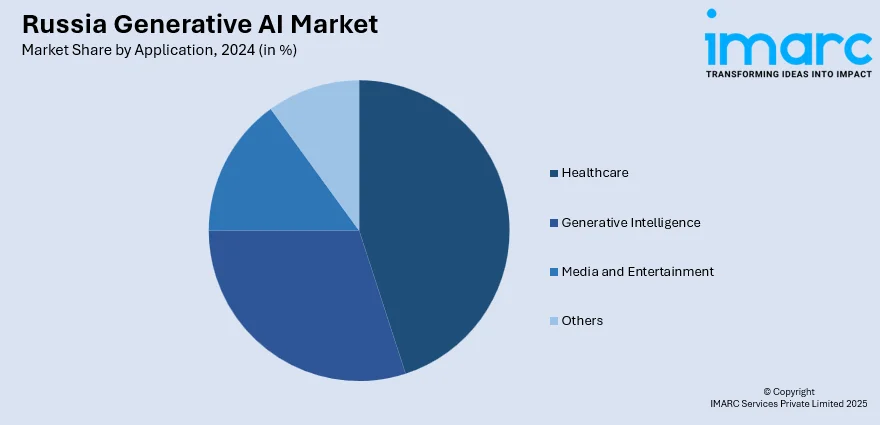
Russia Generative AI Market Size, Share, Trends and Forecast by Offering Type, Technology Type, Application, and Region, 2025-2033
Russia Generative AI Market Overview:
The Russia generative AI market size reached USD 238.14 Million in 2024. Looking forward, the market is expected to reach USD 1,360.71 Million by 2033, exhibiting a growth rate (CAGR) of 19.04% during 2025-2033. The market is driven by Russia’s national focus on technological independence and the expansion of its domestic AI research infrastructure. Growing enterprise demand for AI-driven automation across sectors such as energy, finance, and manufacturing is accelerating application development. Furthermore, sustained government funding and strategic collaborations are propelling research excellence, further augmenting the Russia generative AI market share.
|
Report Attribute
|
Key Statistics
|
|---|---|
|
Base Year
|
2024
|
|
Forecast Years
|
2025-2033
|
|
Historical Years
|
2019-2024
|
| Market Size in 2024 | USD 238.14 Million |
| Market Forecast in 2033 | USD 1,360.71 Million |
| Market Growth Rate 2025-2033 | 19.04% |
Russia Generative AI Market Trends:
Expanding Technological Capabilities and Growing Domestic AI Ecosystem
Russia’s emphasis on technological sovereignty is strengthening its domestic artificial intelligence ecosystem, with generative AI emerging as a strategic focus area. Driven by the government’s National AI Strategy, launched in 2019, the country has intensified investment in research institutions, AI startups, and public-private partnerships. Russian tech enterprises are focusing on developing homegrown generative AI models tailored to domestic linguistic, cultural, and regulatory contexts. The increasing availability of skilled data scientists, coupled with collaborations between universities and the private sector, is fostering innovations in AI model architecture and training methodologies. Generative AI is being applied across sectors such as media, defense, cybersecurity, and even space, generating customized content and language models aligned with national priorities. On June 3, 2025, Russia announced plans to integrate its homegrown Gigachat generative AI model into IT systems on the International Space Station (ISS), as confirmed by Roscosmos chief Dmitry Bakanov. Developed by Sberbank, Gigachat will support cosmonauts by enhancing satellite image resolution from 1 meter per pixel to 0.5 meters, boosting operational efficiency in space missions. This initiative underscores Russia’s ambition to advance sovereign generative AI capabilities. Despite external restrictions on access to certain international AI technologies, domestic advancements remain resilient. Startups and leading technology corporations are also developing alternatives to global foundational AI models to meet the specific needs of Russian enterprises. This emphasis on domestic innovation, combined with a growing research infrastructure, is expected to accelerate Russia generative AI market growth.

To get more information of this market, Request Sample
Government Incentives and Strategic Investments in AI Research
Government policy has played a crucial role in shaping Russia’s generative AI development landscape. The National Strategy for AI Development, alongside initiatives such as the Digital Economy Program, has catalyzed significant funding for AI-focused research and development. Investments have been directed toward establishing AI testbeds, specialized university programs, and innovation hubs for startups working on generative AI applications. Regulatory frameworks are also being adapted to accommodate responsible AI experimentation while ensuring alignment with national security objectives. Russia’s emphasis on technological self-sufficiency includes partnerships between government agencies and technology companies to accelerate domestic AI capabilities. Furthermore, large technology conglomerates are investing in the creation of proprietary large language models tailored specifically for Russian industries, education, and media. On April 23, 2025, UNESCO IITE and UNESCO-ICHEI jointly launched two free Russian-language online courses on generative AI for educators, titled “Generative Artificial Intelligence as a Teaching Tool in Higher Education” and “Prompt Engineering for Higher Education Teachers”. The launch event engaged over 1,000 educators and administrators from Russia and neighboring countries, promoting AI literacy in academic settings. This initiative highlights growing efforts to strengthen digital competencies and advance the integration of generative AI technologies in Russia’s educational and professional ecosystem. In line with this, research organizations are actively exploring advancements in multimodal generative AI that combine text, audio, and visual data synthesis. These strategic initiatives ensure sustained momentum for generative AI innovation, positioning Russia’s technological ecosystem for competitive advantage within global and regional markets.
Russia Generative AI Market Segmentation:
IMARC Group provides an analysis of the key trends in each segment of the market, along with forecasts at the country and regional levels for 2025-2033. Our report has categorized the market based on offering type, technology type, and application.
Offering Type Insights:
- Image
- Video
- Speech
- Others
The report has provided a detailed breakup and analysis of the market based on the offering type. This includes image, video, speech, and others.
Technology Type Insights:
- Autoencoders
- Generative Adversarial Networks
- Others
The report has provided a detailed breakup and analysis of the market based on the technology type. This includes autoencoders, generative adversarial networks, and others.
Application Insights:

- Healthcare
- Generative Intelligence
- Media and Entertainment
- Others
The report has provided a detailed breakup and analysis of the market based on the application. This includes healthcare, generative intelligence, media and entertainment, and others.
Regional Insights:
- Central District
- Volga District
- Urals District
- Northwestern District
- Siberian District
- Others
The report has also provided a comprehensive analysis of all major regional markets. This includes Central District, Volga District, Urals District, Northwestern District, Siberian District, and others.
Competitive Landscape:
The market research report has also provided a comprehensive analysis of the competitive landscape. Competitive analysis such as market structure, key player positioning, top winning strategies, competitive dashboard, and company evaluation quadrant has been covered in the report. Also, detailed profiles of all major companies have been provided.
Russia Generative AI Market News:
- On June 5, 2025, a plenary session of the Artificial Intelligence Journey 2023 international conference on AI and machine learning, titled The Generative AI Revolution: New Opportunities was conducted in Moscow, where President Vladimir Putin underscored the strategic importance of advancing sovereign generative AI technologies. During the event, he directed national stakeholders to increase Russia’s domestic computing capacity by at least 10 times by 2030 to ensure technological sovereignty. The announcement reflects Russia’s focused commitment to accelerating growth in its generative AI market amid intensifying global AI competition.
Russia Generative AI Market Report Coverage:
| Report Features | Details |
|---|---|
| Base Year of the Analysis | 2024 |
| Historical Period | 2019-2024 |
| Forecast Period | 2025-2033 |
| Units | Million USD |
| Scope of the Report |
Exploration of Historical Trends and Market Outlook, Industry Catalysts and Challenges, Segment-Wise Historical and Future Market Assessment:
|
| Offering Types Covered | Image, Video, Speech, Others |
| Technology Types Covered | Autoencoders, Generative Adversarial Networks, Others |
| Applications Covered | Healthcare, Generative Intelligence, Media and Entertainment, Others |
| Regions Covered | Central District, Volga District, Urals District, Northwestern District, Siberian District, Others |
| Customization Scope | 10% Free Customization |
| Post-Sale Analyst Support | 10-12 Weeks |
| Delivery Format | PDF and Excel through Email (We can also provide the editable version of the report in PPT/Word format on special request) |
Key Questions Answered in This Report:
- How has the Russia generative AI market performed so far and how will it perform in the coming years?
- What is the breakup of the Russia generative AI market on the basis of offering type?
- What is the breakup of the Russia generative AI market on the basis of technology type?
- What is the breakup of the Russia generative AI market on the basis of application?
- What is the breakup of the Russia generative AI market on the basis of region?
- What are the various stages in the value chain of the Russia generative AI market?
- What are the key driving factors and challenges in the Russia generative AI market?
- What is the structure of the Russia generative AI market and who are the key players?
- What is the degree of competition in the Russia generative AI market?
Key Benefits for Stakeholders:
- IMARC’s industry report offers a comprehensive quantitative analysis of various market segments, historical and current market trends, market forecasts, and dynamics of the Russia generative AI market from 2019-2033.
- The research report provides the latest information on the market drivers, challenges, and opportunities in the Russia generative AI market.
- Porter's five forces analysis assist stakeholders in assessing the impact of new entrants, competitive rivalry, supplier power, buyer power, and the threat of substitution. It helps stakeholders to analyze the level of competition within the Russia generative AI industry and its attractiveness.
- Competitive landscape allows stakeholders to understand their competitive environment and provides an insight into the current positions of key players in the market.
Need more help?
- Speak to our experienced analysts for insights on the current market scenarios.
- Include additional segments and countries to customize the report as per your requirement.
- Gain an unparalleled competitive advantage in your domain by understanding how to utilize the report and positively impacting your operations and revenue.
- For further assistance, please connect with our analysts.
 Request Customization
Request Customization
 Speak to an Analyst
Speak to an Analyst
 Request Brochure
Request Brochure
 Inquire Before Buying
Inquire Before Buying




.webp)




.webp)












